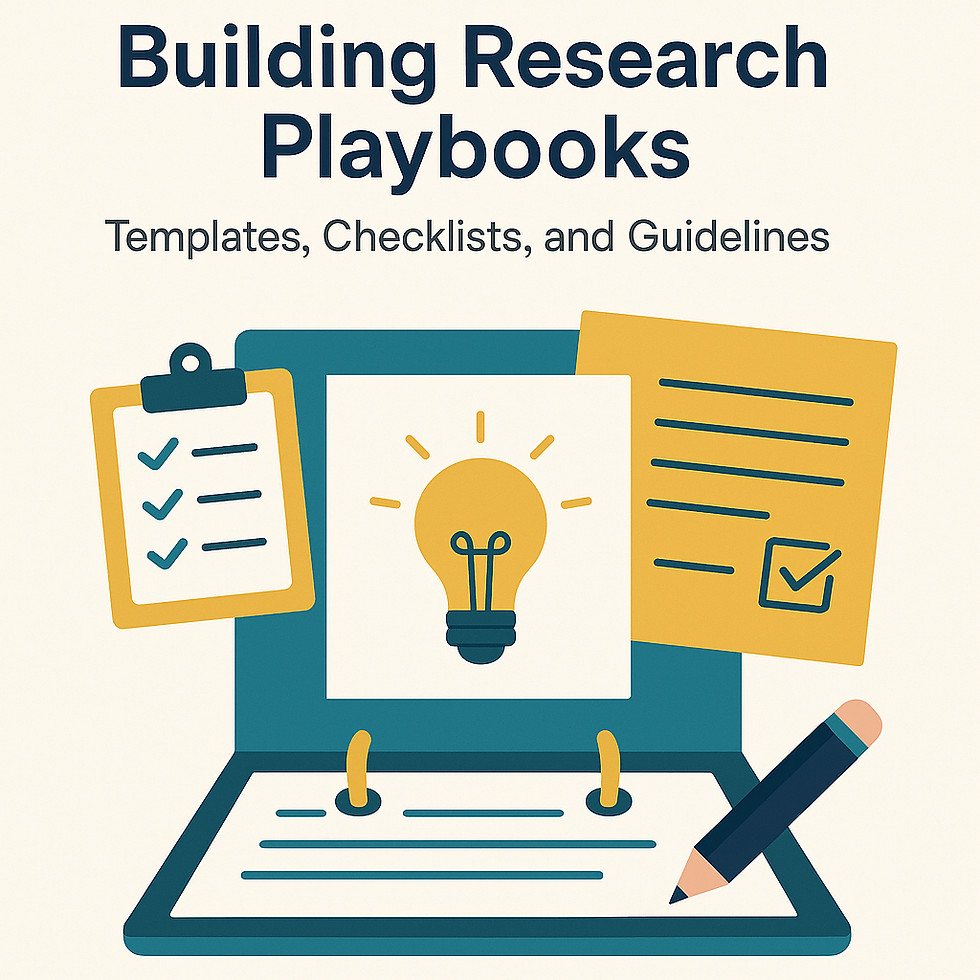Building Research Playbooks: Templates, Checklists, and Guidelines
- Philip Burgess
- Aug 17
- 2 min read
Updated: Oct 26
By Philip Burgess - UX Research Leader
As UX research teams scale, one of the biggest challenges they face is consistency. Different researchers may use different approaches, tools, or reporting styles, which can lead to confusion, duplication, and uneven quality. This is where research playbooks come in.
A well-crafted playbook provides templates, checklists, and guidelines that empower teams to run research efficiently, consistently, and with confidence.
What is a Research Playbook?
A research playbook is a living document that codifies how research gets done in your organization. It’s not about dictating creativity or micromanaging researchers—it’s about creating a shared foundation so research runs smoothly across teams.
Think of it as your team’s go-to manual for:
Standard research templates (plans, scripts, reports)
Step-by-step checklists (to reduce errors and missed details)
Guidelines (covering ethics, recruitment, tool usage, and best practices)
Why Research Playbooks Matter
Consistency at Scale
Ensures studies are conducted with the same rigor, regardless of who runs them.
Efficiency and Time Savings
Reduces time spent reinventing processes or reformatting documents.
Onboarding and Democratization
Helps new researchers (or non-researchers) quickly understand how to conduct studies.
Quality Assurance
Prevents common mistakes and ensures research meets organizational standards.
Strategic Alignment
Keeps research tied to business and product goals.

What to Include in a Research Playbook
A robust playbook should cover three layers: templates, checklists, and guidelines.
1. Templates
Reusable frameworks that save time and standardize documentation.
Research Plan Template: Includes objectives, hypotheses, methods, participants, and success metrics.
Discussion Guide Template: Scripted questions, prompts, and task flows.
Report Template: Findings, themes, recommendations, and impact statements.
2. Checklists
Quick reference tools to ensure nothing gets missed.
Pre-Study Checklist: Consent forms, recruitment confirmation, tool setup, pilot run.
During Study Checklist: Recording devices ready, observers briefed, note-taking protocols.
Post-Study Checklist: Data backups, participant incentives, synthesis plan.
3. Guidelines
Best practices and guardrails to support research quality.
Recruitment Guidelines: How to recruit diverse and representative participants.
Ethics Guidelines: Consent, privacy, and data protection standards.
Tool Usage: Which platforms to use for surveys, usability tests, repositories, etc.
Reporting Guidelines: Storytelling tips and expectations for deliverables.
Best Practices for Building Your Research Playbook
Collaborate Across Teams
Involve researchers, designers, product managers, and even legal/compliance early.
Keep it Simple and Accessible
Use a shared platform (Notion, Confluence, or Google Docs) with clear navigation.
Make it Visual
Flowcharts, diagrams, and icons improve usability.
Keep it Living
Regularly update your playbook as tools, methods, and business goals evolve.
Evangelize It
Introduce the playbook in onboarding, training sessions, and team stand-ups.
Final Thoughts
A research playbook isn’t about restricting creativity—it’s about freeing researchers to focus on insights rather than logistics. By providing templates, checklists, and guidelines, you give your team a reliable structure to operate within, while still leaving room for innovation and exploration.
When done well, a playbook becomes a single source of truth that keeps research consistent, efficient, ethical, and impactful.
Philip Burgess | philipburgess.net | phil@philipburgess.net




Comments